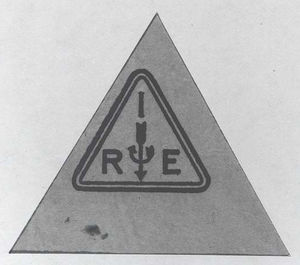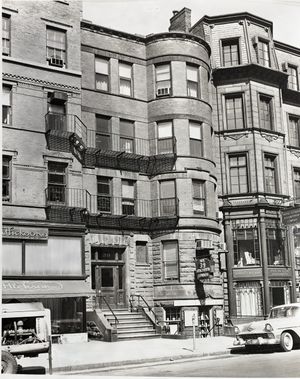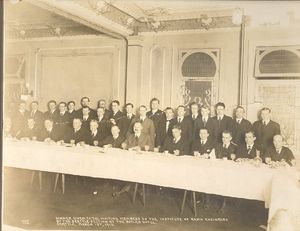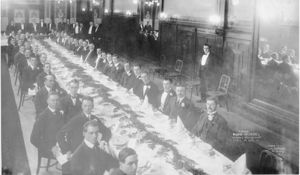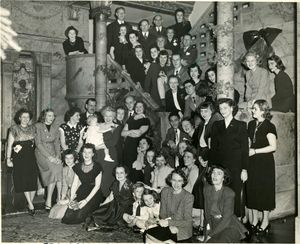IRE History 1912-1963
History of the Institute of Radio Engineers 1912-1963
Origins
At the turn of the century, a new electrical technology--radio, or wireless telegraphy as it was known then--emerged out of principles coming from physics, most notably James Clerk Maxwell's theory of electromagnetic waves. Italian inventor Guglielmo Marconi’s 1901 wireless broadcast of Morse code across the Atlantic began a global period of feverish activity, especially among young men with an technological bent. Along with aviation and automobility, it was the “hot” technology of the day. By 1912, it was a young profession, with radio telegraph stations connecting ships at sea. A month after the Titanic disaster demonstrated the value of the technology, a small group of men representing local wireless societies in New York and Boston met in New York. Led by Robert Marriott, Alfred Goldsmith, and John V. L Hogan, the Institute of Radio Engineers (IRE) formed out of the Society of Wireless Telegraph Engineers (formed in Boston in 1907) and the Wireless Institute (formed in New York in 1909). Marriott became the first IRE president. To a large extent, they modeled their Institute on the AIEE, with membership grades, a journal, local sections, standards activities, and technical meetings, but there were other influences as well. The Proceedings of the IRE followed the processes of scientific journals, with papers directly submitted and peer review. This allowed for faster publication than AIEE’s policy which mandated that papers be presented at meetings first. The founders also deliberately excluded “American” from the organization's name, to signify the transnational nature of radio waves and communications.
Growth of Radio
Radio itself was transformed by the development of the vacuum tube amplifier, the first electronic device, from its origins in the Audion three-element vacuum or electron tube, patented in 1906 by inventor and 1930 IRE President Lee de Forest. Supported by engineers' and physicists' development of electronic circuits and antennas maximizing the amplification, increasing the selectivity, and reducing the noise in communications, Morse code yielded to sound and radio broadcasting swept the world. Between 1920 and 1930 the number of U.S. homes with radios climbed from 0 to 14 million. Radio broadcasting evolved towards large interconnected systems of radio networks, such as the United States' privately owned NBC and CBS; the rest of the world maintained networks as government-operated systems.
The Rise of Electronics
In the 1940s electronics rose to a new prominence as governments throughout the world organized their scientists and engineers to devise technologies for use in World War II. One set of efforts produced pioneering electronic digital computers such as Colossus in England and ENIAC in the United States that used thousands of vacuum tubes. An even larger effort, centered on the euphemistically named Radiation Lab established at MIT, developed radar as an important war tool. To the chagrin of IRE's leaders, physicists played a far more prominent role in these advances than engineers. With the invention in 1947 of the transistor, the first solid-state electronic amplifier and switch, the possibilities for electronics research, development, and application seemed endless.
Rapid Post-War Growth
The IRE grew rapidly alongside these changes, expanding from 6,000 members in 1940 to 17,000 in 1945 and 21,000 in 1950. In 1948, IRE adopted a decentralized “professional group” structure that allowed it to incorporate rapidly developing new fields such as electronic computers and information theory; hold specialized conferences; and publish specialized journals. By 1956, the IRE passed the AIEE in the number of student members as student engineers increasingly turned to electronics instead of electric power. In the following year IRE became the larger society in total number of members as well, even as both societies passed 50,000 enrollments. While the IRE had always accepted members from other countries, most of who joined to receive its highly regarded journals, that number grew as well, and IRE members formed sections in countries including Japan, Italy, Israel, and Colombia. By the early 1960s, IRE had over 90,000 members. The relative rate of growth, and the increasing centrality of electronics to all aspects of electrical engineering, led to increased interest on the part of both societies to merge into a central organization for all electrical engineers. The two societies merged on January 1, 1963 to form the Institute of Electrical and Electronic Engineers (IEEE).
Image Gallery
4th Annual Banquet - The Institute of Radio Engineers, Mayflower Hotel, Washington, DC, 14 May 1929. Alfred Goldsmith is seated at the head table
Further Reading
Centennial Books
The two books the IEEE published in 1984 on the occasion of the centennial of the older predecessor organization, AIEE:
- A. Michael McMahon, The Making of a Profession: A Century of Electrical Engineering in America.
- John D. Ryder and Donald G. Fink, Engineers & Electrons.
- Marriott, Robert H., History of the IRE, 1937 - In 1937, Robert H. Marriott wrote a history of the IRE, which he notes is not "sufficiently complete or uniformly accurate", and features hand-written notes by John Hogan
- Brokaw Mansion: IRE Headquarters 1946-1963
